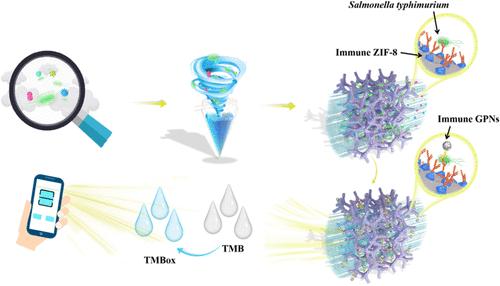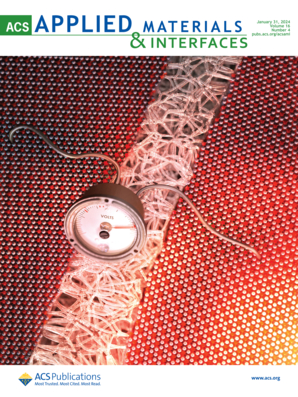Bacterial Bioaerosol-Specific Capture and In Situ Detection Using an Immune ZIF-8-Melamine Foam-Functionalized Colorimetric Biosensor
IF 8.3
2区 材料科学
Q1 MATERIALS SCIENCE, MULTIDISCIPLINARY
引用次数: 0
Abstract
Bioaerosol infections containing pathogenic viruses and bacteria have resulted in significant economic losses and posed a serious threat to public health, as evidenced by outbreaks of coronavirus disease and avian influenza. Consequently, the sampling and screening of bioaerosols are crucial for the prevention of bioaerosol-borne diseases. In this study, an ultrasensitive biosensor based on zeolitic imidazolate framework-8-melamine foam (ZIF-8-MF) was innovatively developed for the specific capture and in situ detection of bioaerosols. The bacterial bioaerosols were collected by a wet cyclone into phosphate-buffered saline (PBS) buffer at a high collection rate, achieving a satisfactory collection efficiency of ∼80% within 10 min. The target bacteria collected in the PBS buffer were specifically captured and effectively concentrated using immune ZIF-8-MF. The gold@platinum nanozymes (GPNs) were employed to specifically label the captured target bacteria and efficiently amplify the biological signal. And the resulting colorimetric signal was analyzed via a self-developed smartphone application (App). This biosensor demonstrated the capability to detect bioaerosols containing Salmonella typhimurium in the range of 1.6 × 102–1.6 × 105 CFU/m3 within 1.5 h, with a detection limit as low as 100 CFU/m3. Compared with other bioaerosol detection methods, the biosensor offered advantages such as high collection rate, specific capture, efficient concentration, and in situ detection, positioning it as a highly promising and practical tool for the monitoring of bioaerosols containing diverse pathogenic bacteria.

求助全文
约1分钟内获得全文
求助全文
来源期刊

ACS Applied Materials & Interfaces
工程技术-材料科学:综合
CiteScore
16.00
自引率
6.30%
发文量
4978
审稿时长
1.8 months
期刊介绍:
ACS Applied Materials & Interfaces is a leading interdisciplinary journal that brings together chemists, engineers, physicists, and biologists to explore the development and utilization of newly-discovered materials and interfacial processes for specific applications. Our journal has experienced remarkable growth since its establishment in 2009, both in terms of the number of articles published and the impact of the research showcased. We are proud to foster a truly global community, with the majority of published articles originating from outside the United States, reflecting the rapid growth of applied research worldwide.
 求助内容:
求助内容: 应助结果提醒方式:
应助结果提醒方式:


